The Orkney Islands are comprised of over seventy islands of which around twenty are inhabited. People have lived there for five and a half thousand years and today the islands are home to some of the best Neolithic sites in Europe.
The Islands were owned by Norway until 1468 and even today many Orcadians view their heritage as quite distinct from that of the Scottish mainland.
These islands are remote, beautiful and quite different from any other of the Scottish islands. They are an ideal destination for anyone interested in the history and historic sites, or who just wishes to enjoy their beautiful scenery and quiet pace of life.
Kirkwall is the main town and is located on the ‘mainland’, the name given to the largest island. There are lots of other islands to explore and it is worth spending a bit of time here to get to know them.
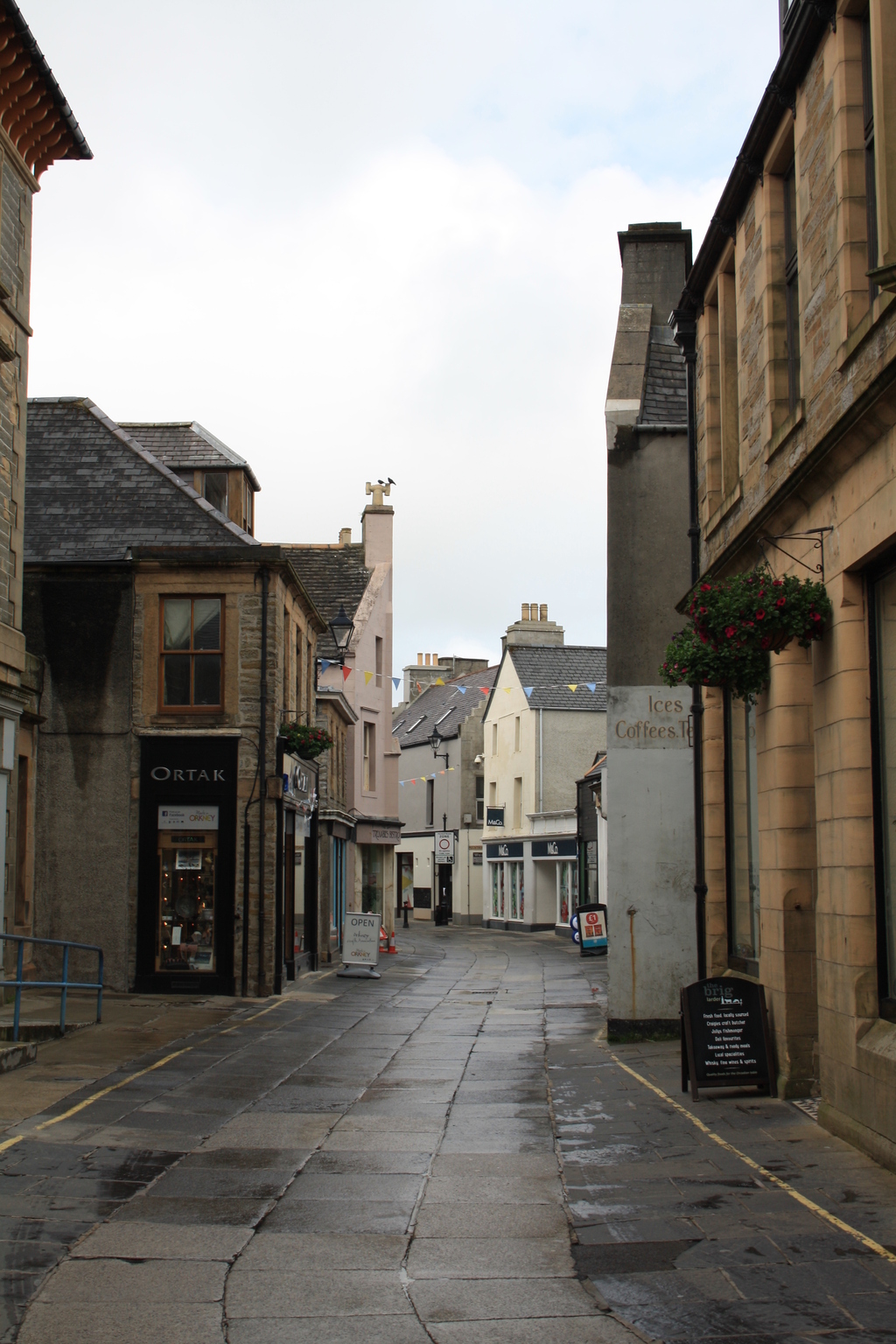
Kirkwall is full of quaint streets
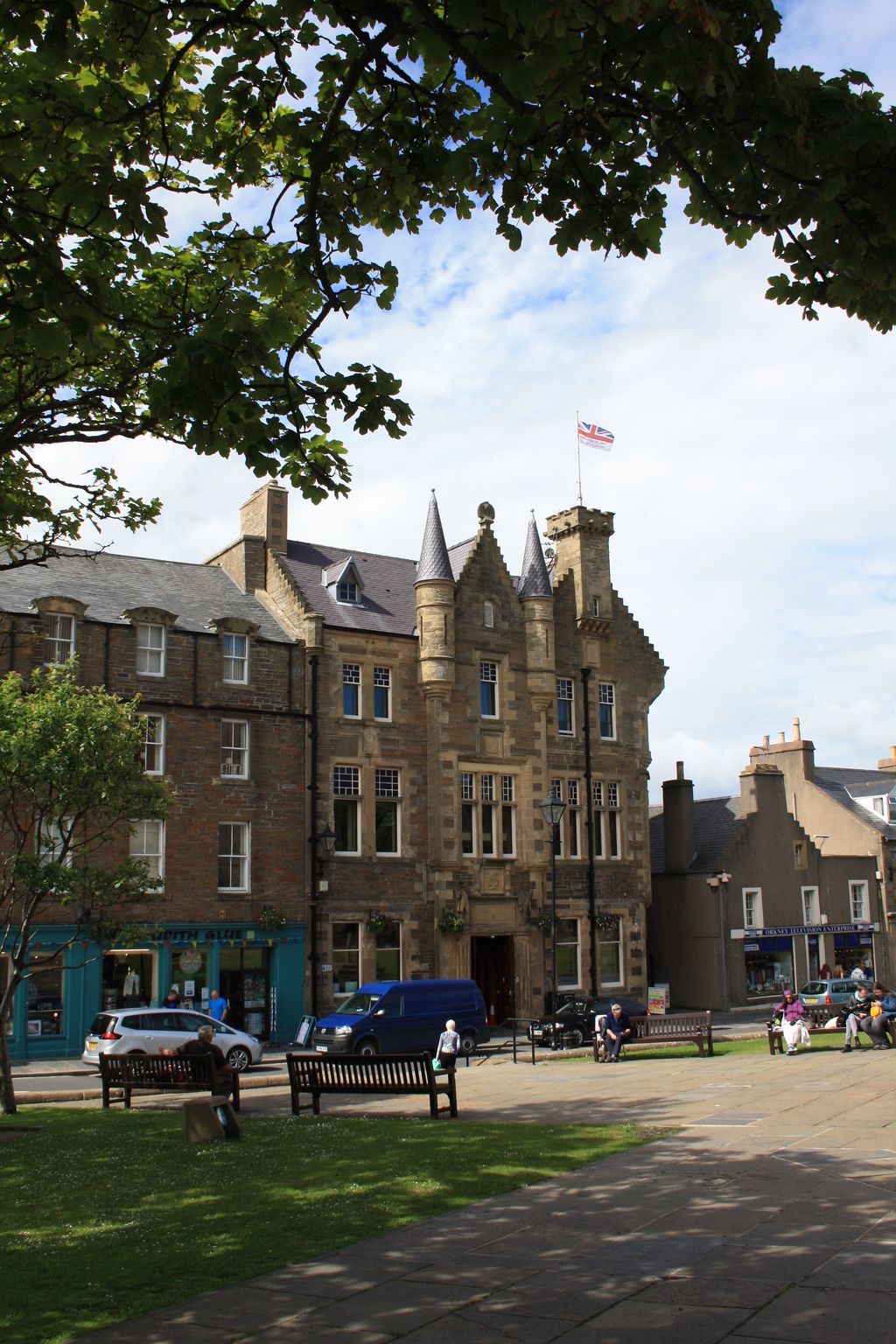
Broad Street Kirkwall
By ferry
NorthLink Ferries from Thurso (Scrabster) to Stromness (more details below), or from Aberdeen to Kirkwall. It is also possible to take one route on your outward journey and a different route on your return journey.
SAVING! Spirit of Scotland Travel Pass and Highland Rover Travel Pass (for rail travel) will entitle you to a 20% discount on NorthLink Seated Standard tickets purchased on the day of travel.
Pentland Ferries from Gills Bay to St Margaret's Hope in South Ronaldsay (see our Guide to Wick and John O' Groats for more details).
By plane
Kirkwall Airport: from Inverness, Aberdeen, Edinburgh, Glasgow, Dundee, Manchester and London Heathrow.
More details of the Thurso to Stromness ferry:
The usual ship is the MV Hamnavoe which is very well appointed with comfortable lounges, a bar, restaurant and shop to keep you entertained on the one and a half hour crossing.
During the summer (usually April until October) it is possible to book a cabin on the 06.30 sailing from Stromness (or on the 09:00 sailing at weekends), avoiding an early departure from your hotel.
Scrabster harbour is about two miles from Thurso. NorthLink Ferries advise rail passengers to pre-book a taxi to Scrabster due to the restricted bus timetable.
SAVING! If you have a Rail & Sail ticket, it should include a taxi transfer from Thurso train station - book via Highland Taxis on 01847 555 555.
There are limited buses running between Thurso and Scrabster. See Stagecoach services 80 and X99 and alight at stop 'Scrabster, Ferry Terminal'.
SAVING! Spirit of Scotland Travel Pass and Highland Rover Travel Pass (for rail travel) includes travel with Stagecoach on the Thurso to Scrabster route.
There is also a new, pre-bookable Ember bus service E6 between Inverness and Scrabster. However, despite stopping at Thurso it is not possible to book a journey between Thurso and Scrabster. There is also a Stagecoach service X99 from Inverness to Scrabster.
Take a small bag with everything you will need for the voyage. It is a good idea to take some warm clothing and jacket if you wish to enjoy the sea air from the open decks.
All other luggage is checked in upon boarding and then collected on arrival at your destination. Bikes are carried free of charge and are taken onboard the car deck and not as hand luggage.
The ferry arrives into Stromness, which is a 30 minute bus journey from Kirkwall, the Islands’ capital. As most bus and internal ferry services have their hub in Kirkwall, it is probably the best place to be located during your stay.
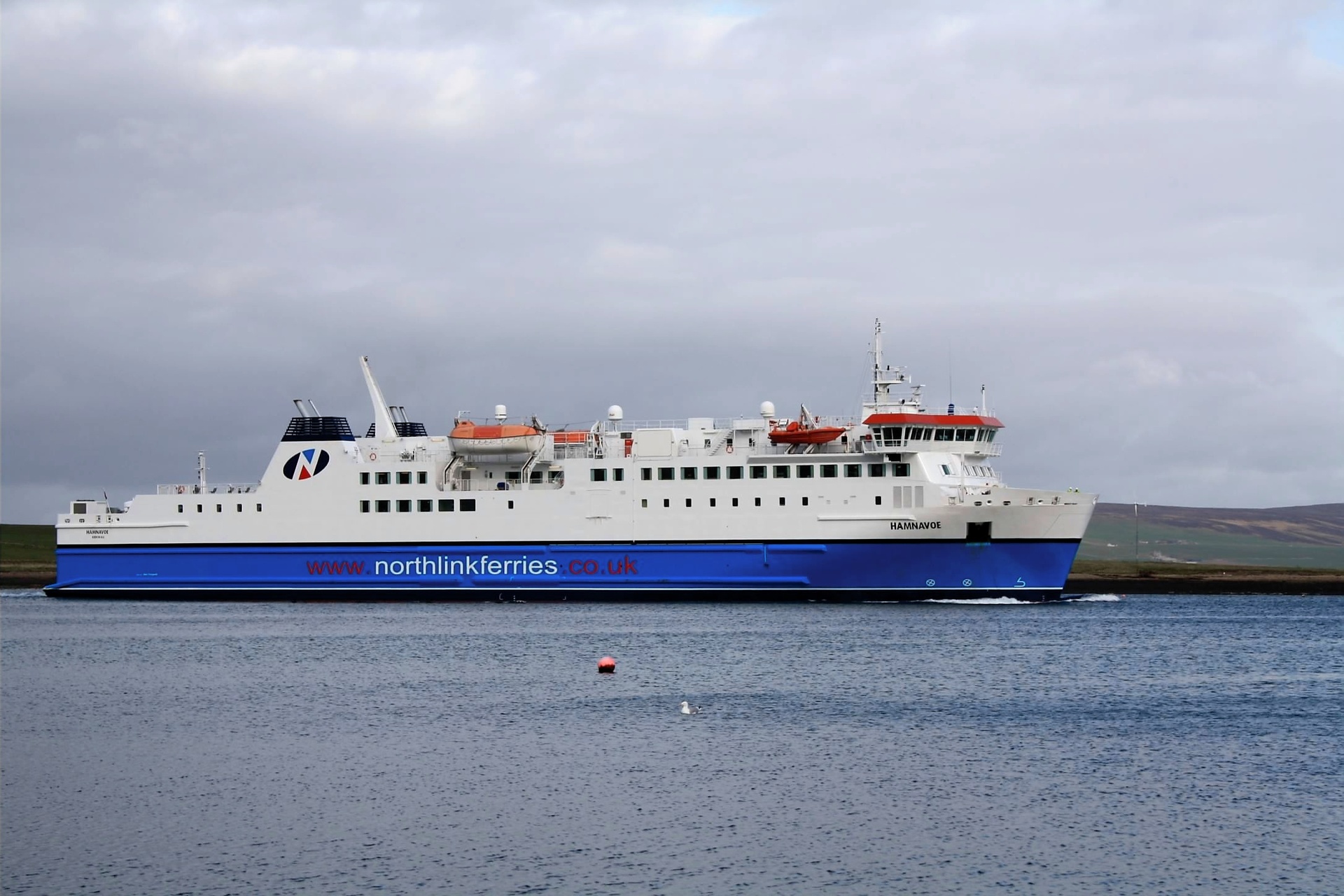
MV Hamnavoe NorthLink Ferries
Although a rural series of islands, Orkney is very well provided with bus services on the mainland. You can get around all the sites of interest using the network of regular bus services and dayrider and megarider tickets mean you have unlimited travel without worrying about taking change for bus fares or how much it is going to cost.
Using the bus on Orkney could not be easier. Outside the towns simply ask the driver to stop at any point of interest or get on wherever you are with a signal to the driver – no need to look out for bus stops!
With quieter roads and small size, the Orkney Islands are also a great place to explore by bike. The smaller islands are often ideal for cycling and walking with limited or no bus services.
Taking the bike to Orkney by ferry and rail is free for the bike although you should remember to make reservations for the train as the rail sections have limited bike space. To find out more about the bus network see Orkney Islands Council Public Bus Services.
There are internal ferries to the smaller Orkney Islands. These are operated by Orkney Ferries. There is also a NorthLink Ferry to Shetland.
This is Orkney has an excellent website with guides to the islands and accommodation details.
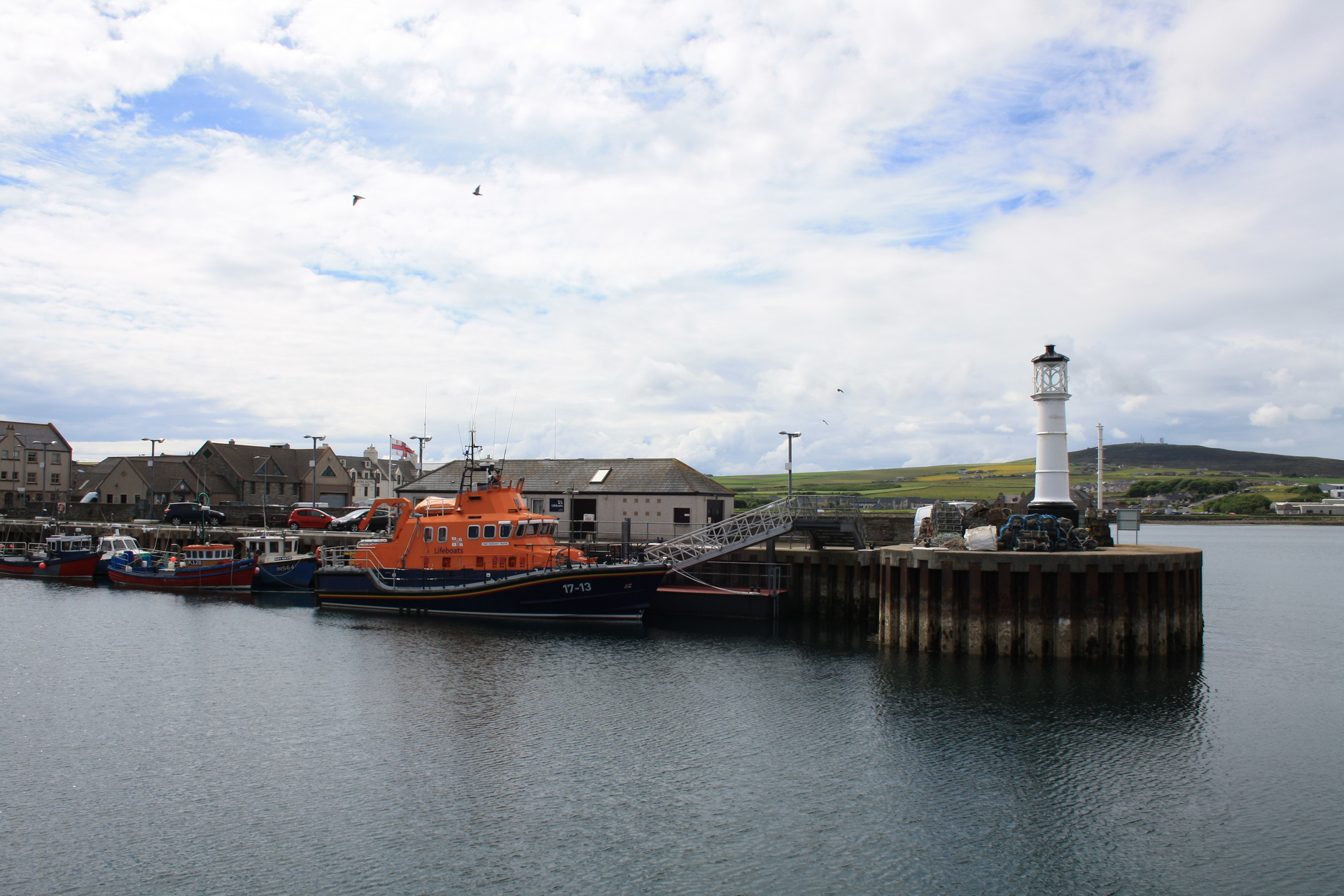
The ferry to Shapinsay departs from West Pier Kirkwall
OTHER ORKNEY ISLANDS
In the centre of Kirkwall is the Basin. Everything that can’t be grown or caught must come in by sea or air, and the harbour has been the focal point of activity on the Island for hundreds of years.
Today this is also the location for local ferries to the smaller Orkney Isles, many of which are ideal for day trips from the mainland for walking, cycling or exploring.
The ferries are run by Orkney Ferries and leave from central Kirkwall to 13 islands destinations. During the summer a special excursion program is operated. Bikes are carried for free.
St Magnus Cathedral, known as the ‘Light in the North’, was founded in 1137 by the Viking, Earl Rognvald, in order of his uncle St Magnus and is the most northerly cathedral in Britain. It is also one of only three Scottish pre Reformation cathedrals still intact.
Between 1154 and 1472 the Cathedral was under the care of the Norwegian archbishops and it was not until 1486 that King James III assigned the Cathedral to the people of Kirkwall. The Cathedral came through the Reformation unscathed although by the 20th century the condition of the building had deteriorated and restoration work was commenced.
The building is constructed of red sandstone and the original builders are thought to have been trained at Durham Cathedral. It is an amazing landmark and literally towers above the Kirkwall skyline.
The Cathedral is located in the centre of Kirkwall and entrance is free. It is open most days and services are held on Sundays.
There are also guided tours of the upper levels throughout the year. There is a charge for these and they should be booked with the custodian on 01856 874894.
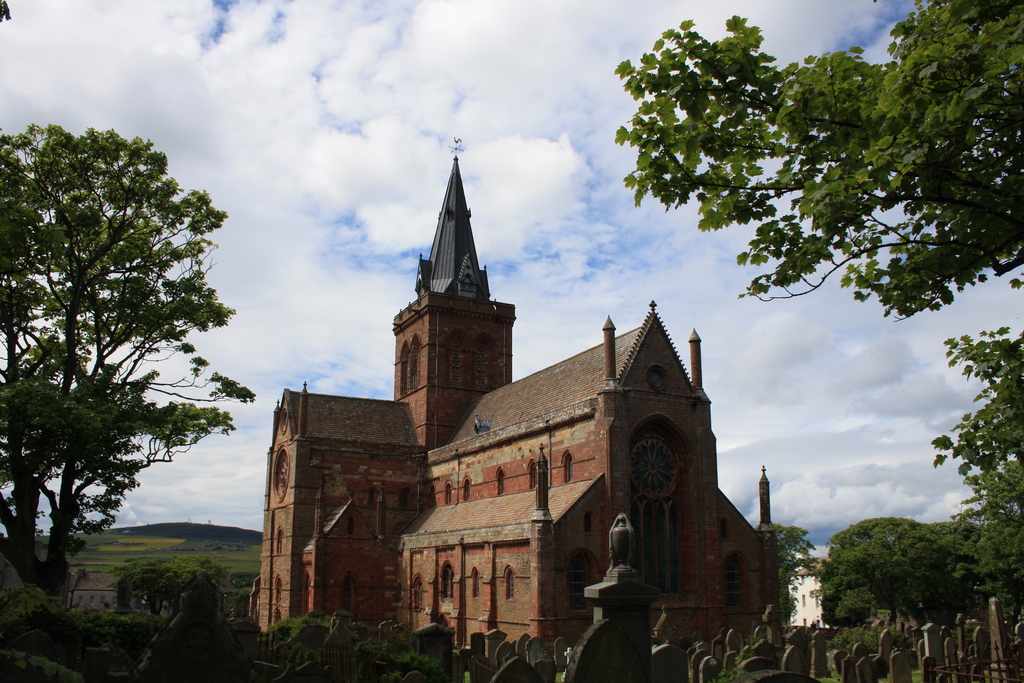
St Magnus Cathedral
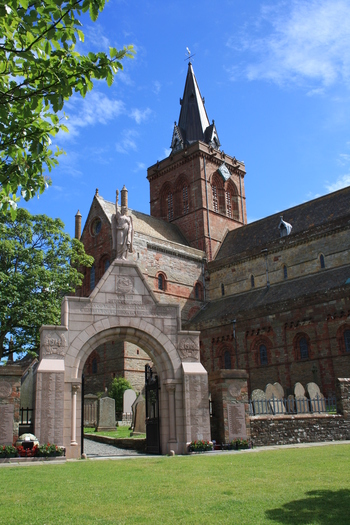
St Magnus Cathedral outside
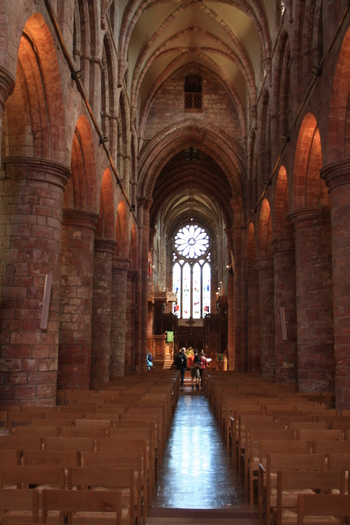
St Magnus Cathedral inside
Kirkwall was the capital of Orkney under the Norse held Northern Isles. However in 1469 when Christian I of Norway failed to pay the dowry promised to his son-in-law, James III of Scotland, the islands were returned to Scotland.
There were two seats of power in Norse Orkney, the Castle (demolished 1615) and the Palace. The Bishop’s Palace was built around the same time as the Cathedral in the 12th century.
In 1263 King Hakon IV of Norway passed away in the Palace while on a visit to Scotland. The Earl’s Palace is much later having been constructed in 1606 by Earl Patrick of Orkney. It is another spectacular building with great detail in its construction.
Both are now ruined but open to the public (admission charge) with a visitor centre. They are five minutes’ walk from the bus and local ferry terminals and located opposite the Cathedral.
Upper floor of the Great Hall, Lair's bedchamber (Earl's Palace) and upper level of Moosie Tower (Bishop's Palace) are currently closed. (September 2025)
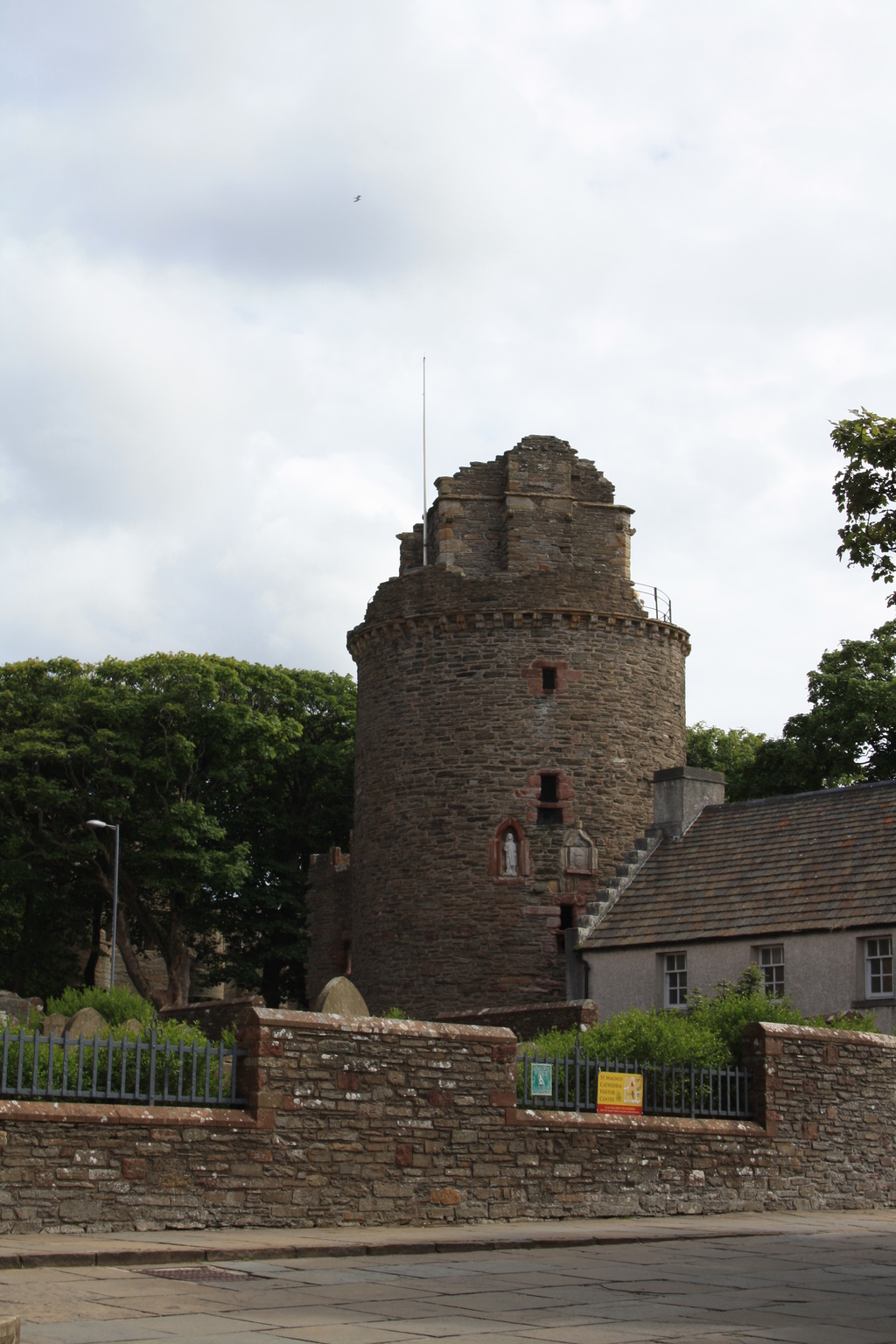
Bishop Reid's Tower, or Moosie Tower
The Museum was built as a house for the Cathedral clergy in 1574 and is well preserved. Entry is through the arched gateway that bears the coat of arms of Gilbert Foulzie who built the house.
Exhibits are of international importance and trace 5000 years of Orkney history. The Museum is located at Tankerness House (opposite the Cathedral).
Founded in 2016, this distillery produces award winning Kirkjuvagr Orkney Gins, rum and blended malt whisky. Ingredients include botanicals grown on Orkney, Orcadian honey and Scottish raspberries.
They offer tours and tastings, and also have a Coffee & Gin Bar and a shop on site. It is 5 minutes' walk from the centre of Kirkwall.
Founded in 1798, they produce a range of single malt whiskies including 12 year, 15 year and 18 year old, using local heathered peat from Hobbister moor. They offer a wide range of tours as well as an experience and tastings their shop on Albert Street in the centre of Kirkwall.
The distillery is 5 minutes' bus journey from the centre of Kirkwall. See Stagecoach service X1 (alight at stop 'Highland Park Car Park' or service 4 (alight at 'Upper Cranit Road' stop followed by a 10 minute walk).
This is one of last manually operated distilleries and is named after the Norse word for boat. Founded in 1885, it produces 10 year, 16 year and 21 year single malt whiskies.
Water is from the nearby Orquil Springs and no peat is used to try the malt. They offer tours and tastings, as well as a series of guided walking trails.
See Stagecoach service 2 for the 5 minute bus journey, alighting at stop 'Scapa, Distillery Cottages'. For The Classic Tour, The Scapa Experience, and The Orcadian, shuttle transfers are available from Great Western Road near the Travel Centre to the distillery, which must be requested at least 24 hours prior.
GLOUP & MULL HEAD NATURE RESERVE, DEERNESS
On the east end of the mainland lies 160 hectares of heath and grassland on a cliff top setting. The sandstone cliffs are home to nesting birds such as kittiwakes, guillemots, razorbills and fulmars.
Other birds, including gulls and skuas, prefer to nest on the open heathland. There is also interesting plant life and some historic buildings including the remains of a Norse chapel at Brough of Deerness.
The site is a 35 minute bus journey from Kirkwall on the bus to Deerness and then a 20 minute walk. There are many pleasant cliff top walks once at the location.
There is also a visitor centre with wildlife information and toilets. It is also possible to cycle out on relatively quiet roads from Kirkwall.
Old Man of Hoy (Ordnance Survey map 7, grid reference 175009).
This is the most famous sea stack in the Orkney Islands and is located on the Island of Hoy. To get there take a bus from Kirkwall (30 minute bus journey from Kirkwall to Stromness) before taking the Orkney Ferries crossing to North Hoy.
The Stack is a six mile walk through the glen between the Ward Hill and Cuilags to Rackwick Bay. There are places to camp or a bothy if staying overnight.
The Stack is also viewable from the NorthLink ferry route from Scrabster.
In 1850 a huge storm unearthed a prehistoric village on the shores of the Bay of Skaill. This village was built over 5000 years ago and is remarkably well preserved. To put that time in context, the Great Pyramid of Giza was not built until 1300 BC.
The houses are remarkably well preserved with even the stone made furniture still intact. The people who lived here were fishermen, hunters and farmers.
However, they found time beyond survival to produce objects of beauty including carved stones. Many of these artefacts have been found and are preserved and on display in the on site museum.
Direct buses run from Kirkwall and the journey takes about 1 hour.
WESTRAY ISLAND AND NOLTLAND CASTLE
Take the ferry from Kirkwall town centre to reach Westray Island. The Island is only 4 miles long by 1 mile wide.
Westray has a nice sandy beach on its south end and a pleasant small harbour. It is mostly farmland and a small community which lives scattered over the Island.
Take some time to visit Noltland Castle, about a mile west of the ferry pier. The castle is not ruined but rather was never completed. It is a fine, Z-plan tower, built between 1560 and 1573 and is remarkable for its large number of gun loops and impressive staircase.
ROUSAY, EGILSAY AND WYRE ISLANDS
These Islands are remote and tranquil. They are reached by Orkney Ferries from Tingwall on the west of the Orkney Mainland.
Reach the ferry terminal by bus or bike from Kirkwall. Bus and ferry times in the summer allow a visit to each island in one day, although it is quite rushed and you may prefer to relax in the isolation of just one of the islands.
Egilsay is noted for the ruins of a 12th century church (St Magnus Church) with its unusual round tower (the interior of the tower is not currently accessible). The Church is half a mile from the ferry pier at grid reference HY 466 304.
Rousay Island has a Neolithic chambered cairn with unusual arrangement of two burial chambers, one above the other. It is known as Taversöe Tuick Chambered Cairn and is located half a mile west of the ferry pier (grid reference HY 426 276).
Also on Rousay is Midhowe Broch. This is a well-preserved broch, with remains of later buildings round it.
A Broch is a large dry-stone, round structure only found in Scotland. It is about an hour’s walk from the ferry pier and has very steep access, following the black and white poles to gain entry.
On the bus route between Stromness and Kirkwall is Maeshowe Cairn. It is the finest chambered cairn in northwest Europe and the finest Neolithic building in Europe.
Thought to be around 5000 years old the tomb itself is quite small, only 4.7 metres across but it is housed in a much larger mounded building covered in earth to resemble a small hill. The passage into the tomb itself is 10 metres long.
This site has been included in the Neolithic Orkney World Heritage Site. Please note that due to the space constraints it is strongly recommended to pre-book online to guarantee entry.
The Chapel is located on the tiny island of Lamb Holm (connected to the Mainland by the first of the Churchill Barriers). It is a unique memorial to 550 Italian Prisoners of War who were interned there in the 1940s.
This beautiful little chapel was converted internally from two corrugated iron nissen huts and has amazing paintings throughout the interior. Considering that the craftsmen had little or no materials it is all the more remarkable for the quality of the workmanship.
Page last updated 9 September 2025